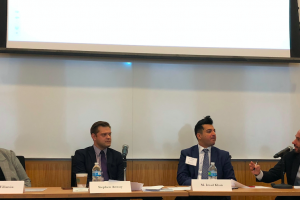Child Labor and International Law – A Clash of Conventions: Business Obligations Regarding Child Labor Issues (IIL Symposium) (1/2)

Source: Aditi Gautam
This piece is part of the American Branch’s second blogging symposium, examining the ILW 2024 theme of ‘Powerless law or law for the powerless?’ from an International Investment Law perspective. This symposium is sponsored by the International Investment Law Committee, but published works are solely those of the authors.
Child Labor and International Law – A Clash of Conventions: Business Obligations Regarding Child Labor Issues
Part 1: International Conventions and Child Labor Issues
by Alan Franklin, JD LLM*
Introduction
Child labour is a major global issue for governments, businesses, international lawyers, non-governmental organizations, and civil society, all of whom are important stakeholders. The United Nations Sustainable Development Goals (SDGs), Target 8.7, seek to end all forms of child labour by 2025, an obvious impossibility.
This two-part blog series will examine child labor from several perspectives, examining the international conventions and instruments governing the issue. As we will see, the various conventions conflict with each other. Also, the concept of the best interests of the child, as articulated by the United Nations Convention on the Rights of the Child, should, in the author’s view, be seen as the supreme principle. Yet, many of the conventions and instruments seem to ignore the best interests of the child.
This paper will critically analyze the International Labour Organization Convention 138 1973 (Minimum Age) (hereafter referred to as ILO Age Convention) and then compare it with the Convention on the Rights of the Child (CRC), highlighting some of the key differences between them. ILO Convention 182 (Worst Forms of Child Labour) will be discussed in the context of the Age Convention and CRC, and show its importance, perhaps legally overshadowing the ILO Age Convention.
This discussion is important to the above-noted stakeholders because most literature, guidance, guidelines, and commentaries on child labor focus almost exclusively on the ILO Age Convention, with little discussion of the CRC and the Worst Forms of Child Labour. To reconcile the contradictions between the Conventions and internal contradictions within the CRC, we must examine the guidance issued by the Committee on the Rights of the Child and that of the United Nations Children’s Fund (UNICEF) on these issues.
Part 1 of this series will therefore present a comprehensive modern interpretation of the child labor issue, presented primarily from the perspective of the best interests of the child, which may not require the ending of all forms of child labor, since it will be shown that even children often agree that child labor can be beneficial to children and society in many situations.
Based on the discussion and analysis in Part 1, Part 2 will discuss the obligations of Business Enterprises regarding child labor issues.
C138 International Labor Organization Age Convention (1973)
Most stakeholders see this Convention as key to understanding international law rules regarding child labor. ILO (Age Convention) To date, 176 countries have ratified this Convention.
Article 3 (1) sets out the general principle: “The minimum age for admission to any type of employment or work which by its nature or the circumstances in which it is carried out is likely to jeopardise the health, safety or morals of young persons shall not be less than 18 years.”
Article 2 allows member states to lower those ages in certain situations and to define the type of work that can be done by those under 18, allowing for a minimum age of 15 generally, but aged 14 for “a Member whose economy and educational facilities are insufficiently developed.” This Convention is prescriptive, without concern for whether these ages are in the best interests of the children involved.
To give an example of the interpretation of the ILO Age Convention. The Canadian Province of Ontario (a highly developed jurisdiction), pursuant to its Occupational Health and Safety Act (OHSA), allows children aged 15 to work in most factories, and children aged 14 can work in restaurants. Thus, state practice often shows that the rules set out in the Age Convention are ignored, even by developed states.
United Nations Convention on the Rights of the Child (‘CRC’) (1989)
This Convention has been ratified by every UN member state except the US. Its focus is children’s rights, in contrast with the ILO Age Convention. It post-dates the ILO Age Convention by 16 years, a significant period of time that allowed the states of the UN to consider many issues regarding children from a very different perspective from the ILO Age Convention.
The CRC, while defining “children” as being under 18, gives children agency by allowing them to make their own decisions regarding work and education, depending upon their maturity and development level, under Articles 12 and 13.
CRC Article 12 (1) provides:
“States Parties shall assure to the child who is capable of forming his or her own views the right to express those views freely in all matters affecting the child, the views of the child being given due weight in accordance with the age and maturity of the child.”
This concept is buttressed by the Charter of Fundamental Rights of the European Union, Article 24: “Children shall have the right to such protection and care as is necessary for their well-being. They may express their views freely. Such views shall be taken into consideration on matters which concern them in accordance with their age and maturity.”
However, within the CRC, we have a seeming internal contradiction regarding the rights of children to express their views, in that Article 32 states:
ONE: States Parties recognize the right of the child to be protected from economic exploitation and from performing any work that is likely to be hazardous or to interfere with the child’s education, or to be harmful to the child’s health or physical, mental, spiritual, moral or social development.
TWO: States Parties shall take legislative, administrative, social and educational measures to ensure the implementation of the present article. To this end, and having regard to the relevant provisions of other international instruments, States Parties shall in particular:
(a) Provide for a minimum age or minimum ages for admission to employment;
(b) Provide for appropriate regulation of the hours and conditions of employment;
(c) Provide for appropriate penalties or other sanctions to ensure the effective enforcement of the present article.
Article 32 incorporates the concepts in the ILO Age Convention regarding the setting of ages. Yet, it refers to economic exploitation as a separate concept – is a child working on a family farm or family enterprise being exploited? Likely not, especially since ILO Age allows states to exclude “family and small-scale holdings producing for local consumption and not regularly employing hired workers.” (Article 5 (3)).
To reconcile this internal contradiction, we must examine the guidance issued by the Committee on the Rights of the Child and the United Nations Children’s Fund (UNICEF) on these issues.
The CRC Committee has published General Comments on interpreting aspects of the CRC. General Comment No. 12 (2009) (the rights of the child to be heard) confirms the child’s rights to be heard and for their views to be respected; the child’s maturity level determines the extent of that respect. A key element thereof is contained in paragraph 30, which states:
“Maturity is difficult to define; in the context of article 12, it is the capacity of a child to express her or his views on issues in a reasonable and independent manner. The impact of the matter on the child must also be taken into consideration. The greater the impact of the outcome on the life of the child, the more relevant the appropriate assessment of the maturity of that child.” (emphasis added)
As the CRC clearly establishes, issues such as work and education significantly impact the outcome of the child’s life, and thus, their views on these matters are very relevant.
This is confirmed by Paragraph 116:
“Children working at younger ages than permitted by laws and International Labour Organization Conventions Nos. 138 (1973) and 182 (1999) have to be heard in child-sensitive settings in order to understand their views of the situation and their best interests. They should be included in the search for a solution, which respects the economic and socio-structural constraints as well as the cultural context under which these children work. Children should also be heard when policies are developed to eliminate the root causes of child labour, in particular regarding education.”
Here, we see clearly that underage children working are not to be dismissed, but instead, solutions must be sought with their views in mind.
Child Exploitation vs Child Labor
Paragraph 117 relates to child exploitation: “Working children have a right to be protected by law against exploitation and should be heard when worksites and conditions of work are examined by inspectors investigating the implementation of labour laws.” Again, we see the necessity of listening to children’s views on these matters, in contrast to the ILO Age, which disregards the views of children.
Paragraphs 105-114 articulate children’s rights regarding education and schooling. If those rights are not adhered to by the state, there is little that states, international organizations, or other stakeholders can do to remedy these international law breaches. Yet, most guidance ignores this reality, suggesting that children should attend school rather than work. One of the key theses of this blog is that children should be entitled to work instead of being forced to remain idle with neither education nor work available to them, or being forced into an education system that is not compliant with their rights. In many developing countries, there may be either no schooling available to poor children or the education is so poor that it is not helpful to children.
CRC General Comment 20 (2016) details the protection of adolescents (aged 10 to 18) from risks which it lists such as substance use and addiction, violence and abuse, sexual or economic exploitation, trafficking, migration, radicalization or recruitment into gangs or militias., but the CRC suggests that adolescents are rarely protected from said risks; families cannot protect, governments refuse to protect and so the solution is often for children to make their own decisions and act upon them, to support themselves, their families, and to grow. Note the comment on page 7 under ‘Best Interests of the Child.’ Paragraph 22 states in part:
“In the light of its general comment No. 14 (2013) on the right of the child to have his or her best interests taken as a primary consideration, the Committee stresses that, when determining best interests, the child’s views should be taken into account, consistent with their evolving capacities and taking into consideration the child’s characteristics. States parties need to ensure that appropriate weight is afforded to the views of adolescents as they acquire understanding and maturity.”
This suggests that states (and thereby international institutions) must consider these issues in setting child labor and education rules rather than the current “one size fits all” system.
Comment 20 refers throughout to preventing the exploitation of adolescents. However, it does not suggest that work not considered exploitative should be disallowed. Paragraph 45 supports this, suggesting that adolescents should be permitted to join trade unions for workers.
Paragraphs 73 and 74 put the burden on the government to ensure proper programs for transitioning from school to work, a crucial element. When governments do not comply with these obligations, children (as well as their families) are left with few options for their development and economic support. One of these options is for children to start working, hoping to get some of that training through their work. Otherwise, we leave children in a limbo situation where they cannot support themselves or their families.
The Section on Child Labour (Paragraphs 84-86) outlines transitioning from education to work, setting out essential intermediate to long-term goals. Adolescents must often work to support themselves or their families in the short term. They cannot await the implementation of these longer-term goals. Paragraph 84 refers to children being protected by the ILO Age Convention. Is this protection real or illusory? Does that Convention take into consideration all of the issues outlined in the CRC regarding the rights of children to be heard, particularly when the protections of that age convention are firstly not being provided to children, and secondly are not subtle enough to provide for the best interests of the child, depending upon circumstances?
UNICEF has published an Implementation Handbook for the Convention on the Rights of the Child, now in its third edition (2007). On page 77, this document states that “[u]sing the concept of ‘evolving capacities’ has avoided the need for the Convention to set arbitrary age limits or definitions of maturity tied to particular issues.” This is one of the Convention’s key concepts – acknowledging that children’s development towards independent adulthood must be respected and promoted throughout childhood.
It is linked to the requirement of CRC Article 12 that children’s views should be given “due weight in accordance with the age and maturity of the child.” The treaty further refers to the rights of the parents to oversee education and work; they are the decision makers, in conjunction with the child, whose views must be respected as the child matures.
In addition to protective legislation and procedures to prevent exploitation of children in employment (Implementation Handbook, pg. 479), under CRC Article 12, respect is required for the views of the child; in any judicial or administrative proceedings relating to employment of children, the child has a right to be heard. Children must also have access to complaints procedures relating to employment. However, “one of the challenges of ending exploitation of child labour is to ensure that children’s often sincere view that they should earn money and help to support the family is also heard and responded to.” (Implementation Handbook, pg. 168) (emphasis added)
Do the Conventions Adhere to the Principle of the Best Interests of the Child?
A compelling argument can be made that the Preamble to the ILO Age Convention 138 was created to gradually abolish child labor globally, but without concern for children’s rights.
The comments published by Open Democracy in an open letter to the CRC Committee dated January 27, 2016, recommended that the guidance regarding the Rights of Adolescents (which was then being prepared by the CRC Committee) not adopt any fixed age limits for child labor states as follows:
“Although the Minimum Age Convention was written before discourse on children’s rights became prominent, it is frequently assumed to be a child rights document.
This assumption is fallacious.
The universal minimum-age policy abridges for children certain human rights that are granted to everyone. Under international human rights law, rights extended to everyone – such as the right to work – may be abridged for children for their own protection. However, the validity of that exception depends on showing that it is necessary (i.e., not achievable by means that do not abridge their rights) and effective (protects children in practice). Neither of these conditions is met by the universal minimum-age policy: children can indeed be protected by measures against harmful work that do not prohibit them from all work; and no evidence that we could find suggests that a universal ban actually protects children, but we have found a number of cases where it clearly worked to their detriment.”
This raises the Vienna Convention on the Law of Treaties (1969) (VCLT) regarding conflicts between treaties on the same subject matter. Article 30 of the VCLT states that in the event of a conflict between treaties regarding the same subject matter, the latter treaty shall govern to the extent of any disputes.
The International Law Commission (ILC) study group published its report, Fragmentation of International Law: Difficulties Arising from the Diversification and Expansion of International Law, in 2006, which studied this issue in depth. In paragraph 24 of that ILC report, they suggest that “conflict exists if it is possible for a party to two treaties to comply with one rule only by thereby failing to comply with another rule. This is the basic situation of incompatibility […] [a] treaty may sometimes frustrate the goals of another treaty without there being any strict incompatibility between their provisions.” Hence, the setting of age restrictions in the ILO Age Convention conflicts with the CRC concept of children having individual human rights and thus agency to make decisions for themselves, based upon their level of maturity. In this conflict situation, the ILC Report at paragraph 320 states that the result is not invalidity of the earlier convention (ILO Age) but that the later convention (CRC) would have relative priority.
Part 2, Obligations of Business Enterprises Regarding Child Labor Issues, can be read here.
 *Alan Franklin practiced law for many years before transitioning into academia and consulting. He taught International Business Risk Management for 12 years in the Executive LLM program at Athabasca University in Canada, and for five years, he taught International Business at the Royal University of Law and Economics in Cambodia. Currently, he is working with international legal experts to develop a global Charter addressing child labour issues in business. He has delivered seminars on child labour in cities including Toronto, Vancouver, New York, and Phnom Penh.
*Alan Franklin practiced law for many years before transitioning into academia and consulting. He taught International Business Risk Management for 12 years in the Executive LLM program at Athabasca University in Canada, and for five years, he taught International Business at the Royal University of Law and Economics in Cambodia. Currently, he is working with international legal experts to develop a global Charter addressing child labour issues in business. He has delivered seminars on child labour in cities including Toronto, Vancouver, New York, and Phnom Penh.
Deprecated: Method hb_options is deprecated since Highend version 3.7. Use highend_option instead. in /home/abila/public_html/wp-content/themes/HighendWP/functions/deprecated.php on line 611



